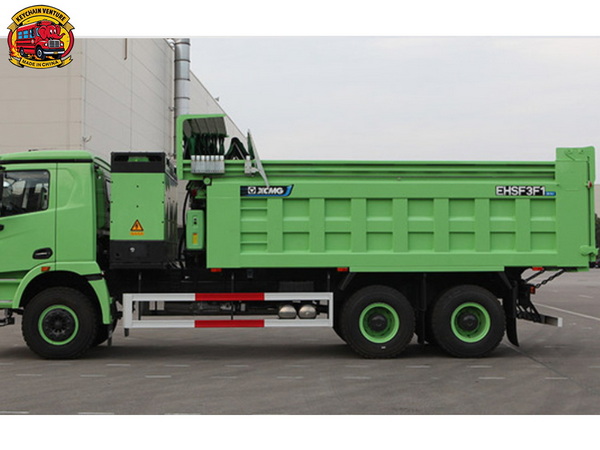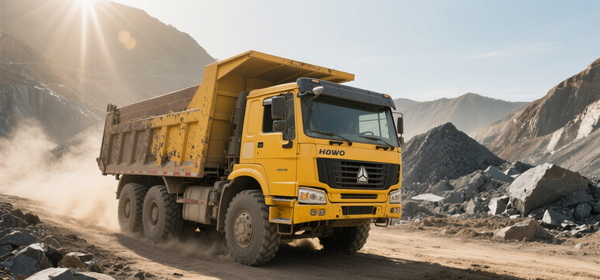Views: 222 Author: Amanda Publish Time: 2025-11-05 Origin: Site








Content Menu
● Introduction: The Role of Dump Trucks
● Main Types of Dump Trucks and Their Capacity
>> 18-Wheeler Dump Trucks and Super Dumps
>> Articulated and Rigid Haulers (Off-Road)
● Factors That Influence Dump Truck Capacity
>> 1. Axle Count and Truck Size
>> 2. Chassis and Structural Design
>> 3. Engine Power and Hydraulic Systems
>> 4. Material Density and Volume
>> 5. Road and Regulatory Limits
● Tailoring Dump Truck Choice to Job Requirements
● Technological Advancements in Dump Truck Design
>> Telematics and Fleet Management
● How to Maximize Hauling Efficiency With Dump Trucks
>> Best Practices for Operators
>> Importance of Regular Maintenance
● Industry Applications: Where Dump Trucks Make the Difference
● Frequently Asked Questions (FAQ)
>> 1. Which dump truck size is best for urban construction projects?
>> 2. What is the heaviest load a dump truck can legally carry?
>> 3. Do dump trucks carry more by tonnage or by volume?
>> 4. How does KeyChain Venture Co., Ltd. support custom dump truck solutions?
>> 5. What innovations are shaping the future of dump trucks?
Dump trucks are indispensable vehicles across construction, mining, waste management, and infrastructure development. Their efficiency in transporting bulk materials directly impacts costs, project timelines, and job site productivity. So, exactly how many tons can a Dump Truck haul? The answer relies on truck type, configuration, road regulations, and the nature of the load material. This deeply-researched guide explains every aspect of dump truck tonnage in detail, helping businesses, operators, and buyers make well-informed decisions.

A dump truck is best known for its large, open-top box bed—hinged at the rear and lifted hydraulically—that can tip to unload its cargo. Whether for moving soil, aggregates, demolition debris, or other loose material, dump trucks offer businesses the versatility to handle logistics at every project scale.[2]
From compact models for inner-city construction to massive off-road rigid haulers used in mining, each class addresses specific hauling requirements. As a premier commercial vehicle supplier, KeyChain Venture Co., Ltd. provides solutions for every hauling scenario with industry-leading dump trucks tailored for reliability and performance.
Understanding the diverse types of dump trucks is essential when selecting the right vehicle for your application. Each class has particular strengths, suited for different jobs and load weights.
- Description: These vehicles feature a typical truck chassis and a dump body mounted to the frame.
- Tonnage Range: 10-16 tons (commonly ~12–16 tons for a tandem axle/10-wheeler, heavier or lighter variants available).[10]
- Key Uses: Construction, urban deliveries, light excavation.
- Capacity: 10–15 tons.
- Benefits: Maneuverability in tight spaces, lower cost, suitable for lighter applications.
- Limitations: Lower maximum legal payload, less stable with heavy or uneven loads.[2]
- Capacity: 16–25 tons.
- Benefits: Higher payload and better stability than single axle, versatile for most construction and hauling jobs.
- Limitations: Larger size may reduce access to small job sites.[3][2]
- Capacity: 26–30 tons.
- Benefits: Maximum legal payload for on-road use, excellent stability, fewer hauls needed for large jobs, suitable for hauling heavy aggregates or debris.
- Limitations: Higher cost, less maneuverable, may face stricter road regulations.[3][2]
- Capacity: 30–40 tons for 18-wheelers; 19–26 tons for Super Dumps with multiple axles.[4][2]
- Benefits: Outstanding payload for long-haul and large-scale construction, reduced trip numbers.
- Limitations: Not practical for small or confined jobs, requires skilled operators.
- Capacity:
- Articulated models: 7 to 25 tons (Hydrema series and similar).[1]
- Large mining/rigid haulers: 40 to 400 tons, tailored for extreme loads and large-scale mining.[9]
- Key Use: Mining, quarry, heavy earthmoving—where road legal limits do not apply.
Dump truck tonnage limits are not solely a function of design; several layers affect a vehicle's real-world hauling capacity.
The number of axles is directly tied to legal payload. More axles distribute weight more evenly, allowing greater loads under road regulations. For example, a tri-axle generally carries several tons more than a tandem model.
Robust, reinforced frames and optimized dump bed geometry boost durability and capacity. Higher-strength materials and modern suspension systems also play a role.[10]
Larger, more powerful engines and advanced hydraulics help dump trucks handle heavy loads without sacrificing safety or unloading efficiency—even with dense or sticky materials.
Not all loads weigh the same per unit volume. Dump trucks are rated for both tonnage and cubic capacity. Dense commodities like gravel or wet sand reach weight limits faster than lighter materials such as mulch or topsoil.
Government laws cap gross vehicle weights and per-axle loads to protect infrastructure and safety. In the United States, the legal gross vehicle weight is often set at 80,000 lbs (36 tons), with per-axle maximums that further restrict allowable load.
Jobsite terrain—paved or off-road, level or sloped, confined or open—influences suitable truck choices. Articulated haulers excel on rough or uneven ground, while standard or tri-axle dump trucks are ideal for road-based, stable environments.

No one dump truck is “best” for every application. Deciding which capacity and configuration are optimal depends on several important project factors:
- Project scale: Large infrastructure, highway, or mining jobs demand higher capacity models to minimize trips and maximize efficiency.
- Material type: Lighter, bulkier loads may call for trucks with larger beds but moderate tonnage, while heavy aggregates push tonnage limits fast.
- Legal restrictions: Regional weight laws, bridge formulas, and site-specific policies may determine maximum permissible loads and impose axle restrictions.
- Site logistics: Jobsites with tight corners or urban congestion require smaller, more maneuverable trucks, even if round trips increase.
As a provider, KeyChain Venture Co., Ltd. helps customers balance these factors, matching every task to the ideal dump truck model from its comprehensive product lineup.
The dump truck industry has seen significant technological upgrades, directly impacting their productivity, safety, and reliability.
- Onboard weighing systems: Allow operators to monitor loads in real time, ensuring regulatory compliance and preventing overloading.
- Advanced traction and braking systems: Provide safer control when fully loaded, especially on uneven or slippery job sites.
- Automated covering systems: Prevent spillage and reduce operator workload.
Modern dump trucks can be equipped with telematics that integrate GPS tracking, load monitoring, route optimization, fuel consumption analytics, and predictive maintenance schedules. These features streamline fleet efficiency and reduce downtime.
As environmental concerns grow, dump truck manufacturers increasingly develop hybrid or alternative fuel models. These reduce emissions and running costs for operators while maintaining robust hauling performance.
Proper usage and maintenance directly affect the efficiency and longevity of dump truck fleets.
- Thorough pre-trip inspections: Ensure load security, tire condition, hydraulic performance, and full compliance with regulations.
- Accurate material estimation: Prevent unnecessary trips by knowing load densities and using onboard weighing systems.
- Strategic route planning: Reduces travel times and wear-and-tear on trucks.
Routine servicing prevents unexpected breakdowns and preserves payload capacity. Operators should focus on hydraulic systems, chassis, brakes, tires, and safety technology.
Ongoing operator training guarantees safe usage, reduces accident risk, and enhances overall project productivity. Skilled drivers are especially needed for larger and more complex dump truck models.
Dump trucks are critical in numerous industries:
- Construction: Roadwork, site preparation, demolition cleanup.
- Mining and Quarrying: Bulk ore, rock, and earth transport in some of the harshest environments.
- Road Maintenance: Asphalt and sand delivery for repairs and upgrades.
- Municipal Waste Management: Moving fill, debris, and recyclables quickly and cost-effectively.
The right dump truck, tailored for each role and material, helps businesses like KeyChain Venture Co., Ltd.'s clients keep their operations running swiftly and safely.
Dump trucks are truly the backbone of modern material transportation, essential in industries from construction and mining to municipal waste. The number of tons a dump truck can haul depends on its size, axle configuration, and model—usually ranging from as little as 7 tons in compact articulated models to a staggering 400 tons in the largest mining haulers. Legal regulations, material density, engine power, and fleet technology must all be factored in to determine the optimal dump truck for your requirements. Businesses who stay abreast of the latest dump truck innovations, and select models suited precisely to their projects, will maximize efficiency, cost-effectiveness, and safety on the job site.

For urban and residential work, smaller dump trucks or tandem-axle models are recommended due to their maneuverability and sufficient payload, typically 10–16 tons. They handle standard construction aggregate and debris while fitting in tight spaces.[10]
The largest road-legal dump trucks, such as tri-axle or Super Dumps, can carry around 26–30 tons in most U.S. jurisdictions, but some off-road mining haulers are capable of carrying up to 400 tons. Always check local bridge and road regulations.[7][9][2]
It depends on the material. Dense materials like gravel will hit the tonnage limit before the truck bed is full, while lighter materials like mulch reach the volume capacity first. Both tonnage and volume are critical to consider.[5]
KeyChain Venture Co., Ltd. specializes in providing dump trucks with tailored features and configurations. They guide clients to the best model for their project, whether requiring increased stability, custom volumes, safety tech, or emissions compliance.
Modern trucks benefit from telematics, real-time weighing systems, hybrid engines, advanced safety aids, and ergonomic designs. These upgrades boost safety, environmental friendliness, and productivity, ensuring dump trucks remain vital in future infrastructure development.
[1](https://dozr.com/blog/articulated-dump-truck-spec-guide)
[2](https://www.grimmsautomovation.com/blog/how-many-tons-can-a-dump-truck-haul-capacity-and-limitations-explained/)
[3](https://www.inland-group.com/news-resources/choose-the-right-dump-truck/)
[4](https://www.customtruck.com/an-in-depth-look-at-dump-trucks-and-how-to-choose-the-right-one/)
[5](https://www.know-howequipment.com/industry-news/dump-truck-load-capacity-a-comprehensive-overview.html)
[6](https://www.truxnow.com/blog/types-of-dump-trucks)
[7](https://northcoasttrucking.com/dump-truck-types-at-a-glance/)
[8](https://constructionmentor.net/standard-on-road-dump-trucks/)
[9](https://www.hardhattraining.com/what-are-the-different-classes-of-dump-trucks/)
[10](https://theupfitinsider.com/p/how-many-tons-can-a-dump-truck-haul)